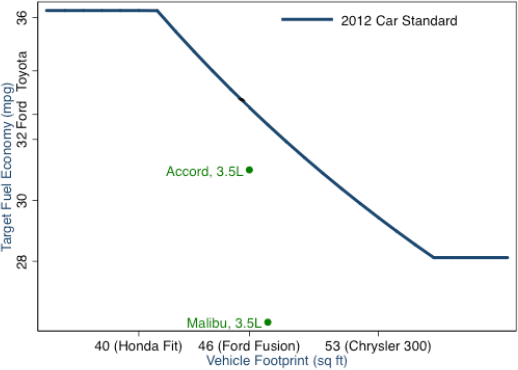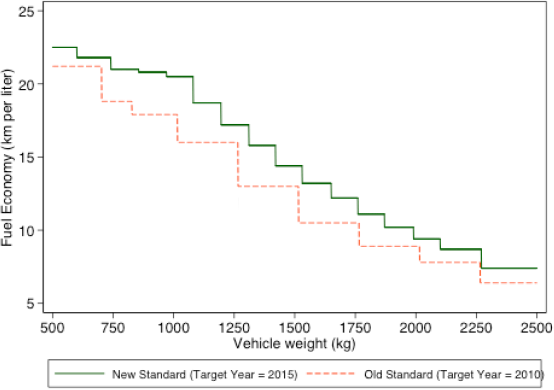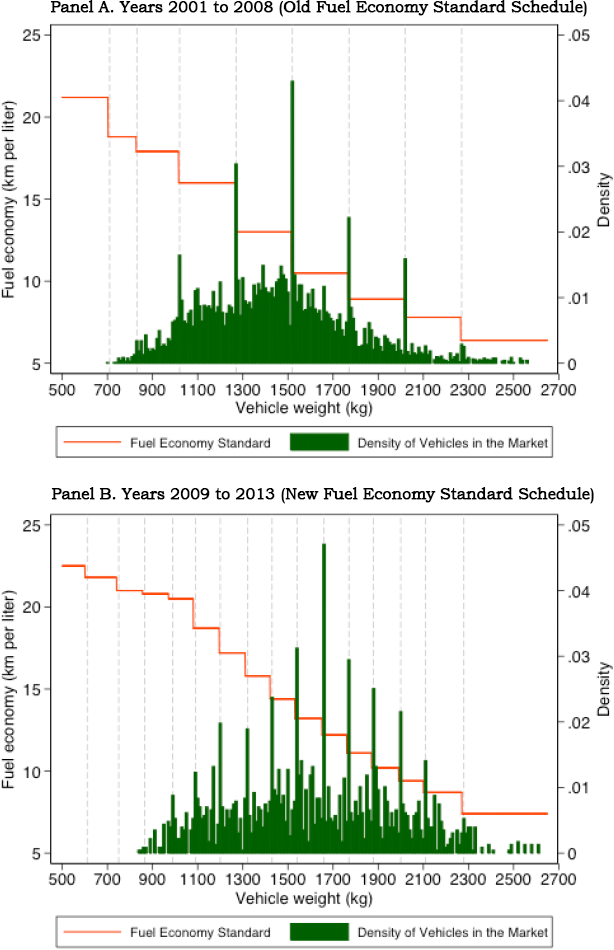In 2012, U.S. President Barack Obama made a fundamental review of the country's Corporate Average Fuel Economy (CAFE) standards. One of the most notable changes adopted in the review was the introduction of a fuel economy target that is a downward sloping function of vehicle footprint. In fact, since the 1970s, Japan has applied a very similar fuel economy standard (using downward-sloping step functions of vehicle weight for fuel economy targets). What are the advantages and potential issues of such policy form? In what follows, I will introduce the paper written by University of Chicago Associate Professor James M. Sallee and myself explaining the above by analyzing theory and evidence.

As shown in Figure 1, the new U.S. policy mandates a fuel economy target that is a downward sloping function of vehicle footprint. In other words, vehicles with smaller footprints are subject to a stricter fuel economy target, while those with larger footprints are allowed to have lower fuel economy.
Upsizing vehicles to clear fuel-economy standards
Needless to say, policy makers are trying to improve the fuel economy of all vehicle models. They want all of the models to move upward in this graph. What we should take into account, however, is the possibility of a model moving to the right instead of upward. Simply put, a car manufacturer could increase a model's footprint rather than improving its fuel economy to clear the standards.
The theory of economics predicts such corporate behavior, but would a fuel economy policy actually lead to an increase of vehicle footprint? The U.S. policy was introduced only recently, and there is not enough data available. This is why we have turned our attention to the Japanese fuel economy standards.

Japan was ahead of the United States in adopting attribute-based regulations on fuel economy. This policy, introduced in the 1970s, has been revised several times, but has maintained its basic policy design as illustrated in Figure 2. The figure shows target values up to and after 2008.
Japanese policy is based on vehicle weight as shown on the horizontal axis. Lighter vehicles are subject to a stricter fuel economy target, while heavier vehicles are allowed to have lower fuel economy. It should be noted also that the Japanese regulations features step-function. The Japanese and U.S. regulations are different in these two aspects, but they provide similar incentives in that lower fuel economy becomes applicable according to vehicle size.
Data analysis approach that makes use of incentive notches
The Japanese policy's step-function characteristic is very useful in our analysis of corporate behaviors. This enables the use of statistical analysis approach that utilizes the notches where incentive levels change, which is one of the approaches that is becoming more widely used among economists.
For example, in the case of a vehicle model that is situated at the level section of the regulatory line, making it slightly heavier would push it over to the next regulatory category to the right. This creates an incentive of increasing the vehicle weight beyond the next notch (left edge of the next regulatory category). Supposing that manufacturers have responded to such incentives, the histogram of the weight of vehicles in market circulation should show heavy concentration at the right edge of each regulatory notch point.
We used publicized data from the annual fuel economy guide by the Ministry of Land, Infrastructure, Transport and Tourism (MLIT) to carry out the analysis. The following histograms show the results:

Figure 3 shows the histogram of vehicle weight for cars sold between 2002 and 2008 (top) and the histogram of vehicle weight for cars sold between 2009 and 2013 (bottom). As theoretically predicted, it is observed that many models are positioned to the right of the regulatory notch points. In other words, the data illustrate how manufacturers are aware of the effect of vehicle weight on fuel economy regulations and have manipulated vehicle weight according to the incentives.
The change of sample distribution before and after the policy change paints an even more convincing picture. The policy amendment changed the locations of the notch points, and the mass points shifted precisely in accordance with the change. This finding provides further compelling evidence that the manufacturers made a rational response to incentives created by the attribute-based regulation. In addition to the analysis based on these graphs, the authors used econometric methods of statistics to estimate the magnitude of weight manipulation caused by this policy.
Weight manipulation causing 100 billion yen of welfare loss
The authors estimate that 10% of Japanese vehicles on the market have had their weight increased by 110 kilograms on average. What has been the social impact of this weight increase, caused as an unexpected policy effect?
Weight manipulation causes two types of social costs. The first is deviation of actual vehicle weights from the optimum vehicle weights determined by the market, caused by the regulation. This generates what is known in economics as deadweight.
Second, weight manipulation interferes with safety related issues at the time of an accident. Latest economic studies have shown that the increase of vehicle weight boosts the safety of the vehicle itself in an accident, but causes a statistically significant rise in damage to the other vehicles or fatalities. The authors also calculated the two abovementioned costs. They estimate that, for the second safety related welfare implication alone, the weight manipulation creates around 100 billion yen of deadweight loss per year in the Japanese car market.
Political benefits of such policies
The authors define this type of policies as attribute-based regulation (ABR). This paper has examined the negative aspects of ABR until now. What about its benefits? The paper also analyzed ABR's potential benefits.
One of the political benefits often discussed is the ABR policy's function of passing the cost burden of manufacturers and buyers of large vehicles to manufacturers and buyers of small vehicles.
For example, imagine a flat fuel economy standard which applies uniform requirements on all vehicles. In this scenario, larger vehicles are expected to suffer a greater compliance cost. This could cause the manufacturers, which produce a relatively large number of large vehicles, and consumers, who want to buy a large vehicle, to become disgruntled, thinking that it is unfair for them to have to bear a greater cost burden. Faced with the need to address such a political demand, policy makers might adopt a policy of allowing lower fuel economy based on vehicle size for political reasons.
However, there are three factors that must be kept in mind in examining the ABR policy's political benefits. The first is the fact that, regardless of the political benefit, ABR would cause the aforementioned negative effect of creating a weight manipulation incentive. The second is the questionable nature of giving a preferential treatment to large vehicles, considering that the true aim of the policy is to improve fuel economy across our society.
If we were to achieve fuel economy improvement across our society, there would be greater compliance burden on large vehicles with poor fuel economy, naturally driving their prices higher. This would not, however, drive them out of the market, as consumers would pay the higher prices if they see value in large vehicles.
Using the terminology of economics, if fuel economy actually has market externality (Note: U.S. environmental economists are in heated debate as to whether it is appropriate to target fuel economy itself as externality, but this paper refrains from weighing in on the argument), there should be policy intervention to equalize the cost of compliance burden according to the targeted externality.
The third factor is the regressive (antonym of progressive, i.e., reducing the burden of high income earners and increasing the burden of low income earners) potential of a policy which preferentially treats large vehicles. Both in Japan and the United States, the size of a car owned is known to have a positive correlation with the person's income. If one of the policy goals is to keep low income earners' burden relatively low, the aforementioned ABR policy design becomes highly questionable. These are the ABR policy's political benefits and factors that must be taken into consideration.
What are the economic benefits of the ABR policy?
Now, let me refer to the economic benefits that have been discussed. Compared to the flat regulation policy, ABR has the potential of reducing society's overall costs of regulatory compliance. In terms of the basic principle of regulatory economics, the desirable policy for improving society's overall fuel economy with minimal costs would be to equalize the marginal cost of compliance in all products.
For the benefit of those who are unfamiliar with economics, the desirable policy would be to equalize the cost of achieving one unit of fuel economy improvement (= marginal cost) in all vehicles. Consider the case of the flat regulation policy, which demands a uniform level of fuel economy for all vehicles. Supposing that the target fuel economy is 20 km/liter, let us examine the marginal costs of Vehicle A (with the current fuel economy of 19 km/liter) and Vehicle B (with the current fuel economy of 10 km/liter).
In this example, Vehicle B, which has poorer fuel economy at present, needs to improve it by 10 additional units. The marginal cost of this vehicle (cost of improving its fuel economy by one additional unit after bringing it to 19 km/liter) is expected to be significantly higher than that of Vehicle A.
It is easily imaginable that the additional cost of making one last unit of improvement after achieving a 9-unit improvement would be sizeable. This means the marginal cost of regulatory compliance would be significantly different between Vehicle A and Vehicle B. It is reasonable to argue that, in order to address the inefficiency, Vehicle A and Vehicle B should each make five units of improvement, thereby reducing the overall cost to society.
This is why some argue that ABR, adopted for fuel economy compliance in Japan and the United States, is aimed at the aforementioned enhancement of economic efficiency. However, this paper presents a better approach to fulfill this aim.
Compliance trading scheme as the optimum policy design
The authors suggest the introduction of a compliance trading scheme (allowing companies to sell their "excess compliance" to other firms).
First, a flat standard of fuel economy is applied to all vehicles. Then, companies that exceed the standard are able to sell their "excess compliance" to other firms. This means that companies which would have to spend substantial costs for meeting the standard can buy excess compliance from companies which can improve fuel economy relatively cheaply. Does this remind you of a similar scheme? It is like the emission trading scheme. The basic concept is the same.
This mechanism, based on the same concept as the emissions trading scheme, has two benefits. First, it can impose a flat fuel economy standard regardless of weight or size, thereby not creating an incentive for making vehicles heavier or larger. Second, the trading of excess compliance harmonizes marginal costs of compliance across all vehicles. It might seem like magic, but such benefits are the strength of environmental policy based on the market mechanism.
In fact, the new ABR system introduced in 2012 by the Obama administration has this compliance trading scheme already incorporated. On the other hand, the Japanese system has yet to allow such trading between companies. Introducing the trading scheme would require a system design that ensures appropriate and competitive trading. Yet, the conclusion of this paper indicates that such a scheme is a policy design worth consideration in Japan in the near future.
* This article is based on Ito, Koichiro and James M. Sallee, "The Economics of Attribute-Based Regulation: Theory and Evidence from Fuel-Economy Standards," NBER Working Paper #20500. For more detailed analysis and discussion, please refer to the paper. Forthcoming in The Review of Economics and Statistics.


